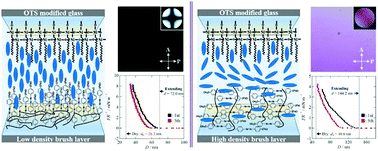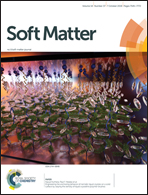Engineering the anchoring behavior of nematic liquid crystals on a solid surface by varying the density of liquid crystalline polymer brushes
Abstract
Controlling the orientation of liquid crystal (LC) molecules towards contacting surfaces is a crucial requirement for the development of LC displays and passive electro-optical devices. Up to now, research has been focused on photo-responses of a LC azobenzene polymer system to obtain either planar or homeotropic orientation of LCs. It remains a challenge, however, to tune the polar angle of LC molecules on the solid surface and gain more insights about the polymer chain conformation extending in LC medium. Here, we deposit a liquid crystalline side chain polymer brush, poly(6-(4-methoxy-azobenzene-4′-oxy)hexyl methacrylate) (PMMAZO), onto the solid surface with film thickness varying between ∼3 nm and 13 nm; therefore, the grafting density of the brush layer ranges from 0.0219 to 0.0924 chains per nm2. When LCs are confined in hybrid cells with a top surface eliciting uniform homeotropic anchoring and a bottom surface covered by the PMMAZO brush, the out-of-plane polar angle of 4-pentyl-4′-cyanobiphenyl (5CB) on the brush layer gradually changes from ∼0° to ∼62° by simply increasing the grafting brush density. The surface forces apparatus (SFA) measurement is used to determine 5CB as a good solvent for the PMMAZO brush and understand the relationship between the chain conformation in 5CB and the anchoring behavior of LC molecules on the polymer brush layer. For high grafting density, the polymer chain in 5CB extends significantly away from the substrate, making the side chain mesogens on average almost parallel to the substrate; for the low-density case, the main chain extends in the narrow region around the surface for aligning the mesogens perpendicular to the substrate.



 Please wait while we load your content...
Please wait while we load your content...
